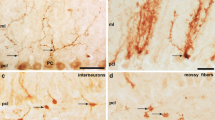Abstract
The adult cerebellar cortex is compartmentalized into longitudinal stripes, in which Purkinje cells (PCs) have compartment-specific molecular expression profiles. Since the striped compartments have specific afferent and efferent projection patterns, they underlie the functional localization of the cerebellum. How these compartments form during development is generally not understood. Our recent study focuses on development of the cerebellar compartmentalization from embryonic day 17.5 (E17.5), when embryonic clustered compartmentalization is evidently observed, to postnatal day 6 (P6), when adult-type striped compartmentalization begins to be established, in mouse. FoxP2, one of the marker molecules for immature PCs, has been used to identify E17.5 PCs. PC subsets or clusters have been distinguished from each other by using different expression profiles of several marker molecules (PLCβ4, EphA4, Pcdh10, and a reporter molecule of the 1NM13 transgenic mouse strain). Analysis of spatial organization of PC clusters by three-dimensional reconstruction from multiple-stained serial sections has indicated 54 PC clusters in the E17.5 cerebellum. Individual clusters are spatially rearranged into stripes in the period from E17.5 to P6. In summary, the clustered compartments in the E17.5 cerebellum are basically direct origin of the adult-type striped compartments in the cerebellar cortex.

Similar content being viewed by others
References
Ahn AH, Dziennis S, Hawkes R, Herrup K. The cloning of zebrin II reveals its identity with aldolase C. Development. 1994;120:2081–90.
Brochu G, Maler L, Hawkes R. Zebrin II: a polypeptide antigen expressed selectively by Purkinje cells reveals compartments in rat and fish cerebellum. J Comp Neurol. 1990;291:538–52.
Voogd J, Pardoe J, Ruigrok TJ, Apps R. The distribution of climbing and mossy fiber collateral branches from the copula pyramidis and the paramedian lobule: congruence of climbing fiber cortical zones and the pattern of zebrin banding within the rat cerebellum. J Neurosci. 2003;23:4645–56.
Sugihara I, Shinoda Y. Molecular, topographic, and functional organization of the cerebellar cortex: a study with combined aldolase C and olivocerebellar labeling. J Neurosci. 2004;24:8771–85.
Sugihara I, Fujita H, Na J, Quy PN, Li BY, Ikeda D. Projection of reconstructed single Purkinje cell axons in relation to the cortical and nuclear aldolase C compartments of the rat cerebellum. J Comp Neurol. 2009;512:282–304.
Altman J, Bayer SA. Embryonic development of the rat cerebellum. III. Regional differences in the time of origin, migration, and settling of Purkinje cells. J Comp Neurol. 1987;257:477–89.
Wassef M, Sotelo C. Asynchrony in the expression of guanosine 3′:5′-phosphate-dependent protein kinase by clusters of Purkinje cells during the perinatal development of rat cerebellum. Neuroscience. 1984;13:1217–41.
Millen KJ, Hui CC, Joyner AL. A role for En-2 and other murine homologues of Drosophila segment polarity genes in regulating positional information in the developing cerebellum. Development. 1995;121:3935–45.
Fujita H, Morita N, Furuichi T, Sugihara I. Clustered fine compartmentalization of the mouse embryonic cerebellar cortex and its rearrangement into the postnatal striped configuration. J Neurosci. 2012;32:15688–703.
Fujita H, Sugihara I. FoxP2 expression in the cerebellum and inferior olive: development of the transverse stripe-shaped expression pattern in the mouse cerebellar cortex. J Comp Neurol. 2012;520:656–77.
Marzban H, Chung S, Watanabe M, Hawkes R. Phospholipase Cβ4 expression reveals the continuity of cerebellar topography through development. J Comp Neurol. 2007;502:857–71.
Hashimoto M, Mikoshiba K. Mediolateral compartmentalization of the cerebellum is determined on the "birth date" of Purkinje cells. J Neurosci. 2003;23:11342–51.
Furutama D, Morita N, Takano R, Sekine Y, Sadakata T, Shinoda Y, Hayashi K, Mishima Y, Mikoshiba K, Hawkes R, Furuichi T. Expression of the IP3R1 promoter-driven nls-lacZ transgene in Purkinje cell parasagittal arrays of developing mouse cerebellum. J Neurosci Res. 2010;88:2810–25.
Luckner R, Obst-Pernberg K, Hirano S, Suzuki ST, Redies C. Granule cell raphes in the developing mouse cerebellum. Cell Tissue Res. 2001;303:159–72.
Sarna JR, Marzban H, Watanabe M, Hawkes R. Complementary stripes of phospholipase Cbeta3 and Cbeta4 expression by Purkinje cell subsets in the mouse cerebellum. J Comp Neurol. 2006;496:303–13.
Author information
Authors and Affiliations
Corresponding author
Rights and permissions
About this article
Cite this article
Sugihara, I., Fujita, H. Peri- and Postnatal Development of Cerebellar Compartments in the Mouse. Cerebellum 12, 325–327 (2013). https://doi.org/10.1007/s12311-013-0450-6
Published:
Issue Date:
DOI: https://doi.org/10.1007/s12311-013-0450-6




